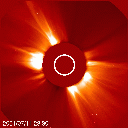You may say, "Solar activity was not high, since the GOES background was much below C-level and there were only three M-class flares for these two weeks." You are quite right as far as flare activity is concerned. However, flares are not the only form of solar activity, as we have said several times in these nuggets. Actually, let's look at this LASCO movie, which covers nearly the same period as the above plot. How exciting these weeks were! Do you think the same?
By looking at this movie closely, you may see that many of major CME events are likely to have come from a large vague region, a little north of NOAA 9535 in the northern hemisphere.
What is interesting is that this region was not accompanied by distinct sunspots beneath it, but was located on the boundary of strong unipolar regions. NOAA gave this region a number, 9544, for only a few days (17-19, July), during which it produced no attractive events. Before and after these days, however, NOAA had no name for this region, in spite of its great activity described below. Closer views of NOAA 9544 below are the images taken from the BBSO Active Region Monitor .
This region produced at least four major events observed with SXT. The timings of these events are shown by the arrows in the above plot of the GOES flux.
SXT movie java and mpeg (133kB)
java and mpeg (133kB)  LASCO movie
LASCO movie
Now, we are looking at another disk passage of this region. Alas! As of 10-Aug., this region still keeps the elongated shape since the previous rotation. Even it looks like a huge sigmoid. Let us watch its behavior carefully.